
Gentiana acaulis, the stemless gentian, or trumpet gentian, is a species of flowering plant in the family Gentianaceae, native to central and southern Europe, from Spain east to the Balkans, growing especially in mountainous regions, such as the Alps and Pyrenees, at heights of 800–3,000 m (2,625–9,843 ft).
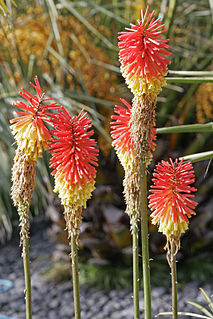
Kniphofia, also called tritoma, red hot poker, torch lily, or poker plant, is a genus of perennial flowering plants in the family Asphodelaceae, first described as a genus in 1794. It is native to Africa.
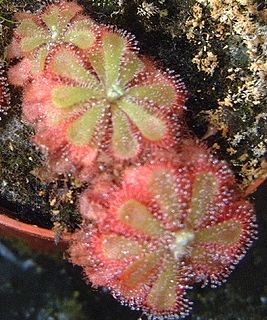
Drosera aliciae, the Alice sundew, is a carnivorous plant in the family Droseraceae. It is native to the Cape Provinces of South Africa, like Drosera capensis, the cape sundew, and is one of the most common sundews in cultivation. The plant forms small, tight rosettes of wedge-shaped leaves, up to 5 cm in diameter. Under conditions of good lighting, the insect-snagging tentacles will become deeply coloured with anthocyanin pigments, which probably aid in its attraction of insect prey. The plant is relatively easy to grow, and produces attractive scapes of pink flowers, which are held about 30 cm away from the carnivorous leaves, so as to prevent pollinators from becoming ensnared. D. aliciae is very similar in form to a number of other closely related species such as D. slackii, and D. dielsiana: the former is rather larger ; the latter rather smaller.

Ornithogalum dubium, common names sun star or star of Bethlehem, is a species of flowering plant in the family Asparagaceae, subfamily Scilloideae. It is a South African endemic.

Freesia laxa, commonly known as flowering grass, is a small species of cormous flowering plant in the family Iridaceae, from eastern and southern Africa, from Kenya to northeastern South Africa. It is grown in gardens as an ornamental plant.
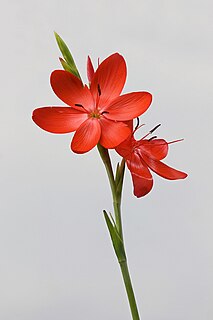
Hesperantha coccinea, the river lily, or crimson flag lily, is a species of flowering plant in the iris family Iridaceae, native to Southern Africa and Zimbabwe.
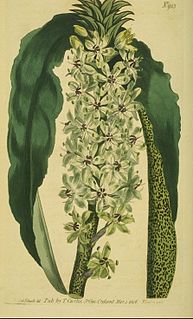
Eucomis comosa, the pineapple flower, pineapple lily or wine eucomis, is a species of flowering plant in the asparagus family Asparagaceae. A deciduous bulbous perennial used as an ornamental plant, it is endemic to South Africa. The white to purple flowers appear in summer and are arranged in a spike (raceme), topped by a "head" of green leaflike bracts.

Plumbago auriculata, the cape leadwort, blue plumbago or Cape plumbago, is a species of flowering plant in the family Plumbaginaceae, native to South Africa.

Haemanthus albiflos is a species of flowering plant in the family Amaryllidaceae, native to South Africa. It is sometimes given the English name paintbrush, not to be confused with Castilleja species which also have this name. It is an evergreen bulbous perennial geophyte, prized horticulturally for its unusual appearance and extreme tolerance of neglect. H. albiflos is the only Haemanthus species found in both winter and summer rainfall regions, and has a mainly coastal distribution from the southern Cape through the Eastern Cape to KwaZulu-Natal, showing a preference for cool, shady spots.
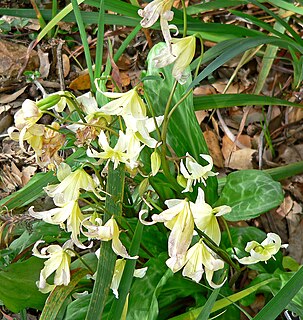
Erythronium californicum, the California fawn lily, is a species of flowering plant in the family Liliaceae, endemic to moist woodland habitats in the mountains of Northern California.

Euryops pectinatus, the grey-leaved euryops, is a species of flowering plant in the family Asteraceae, endemic to rocky, sandstone slopes in the Western Cape of South Africa.
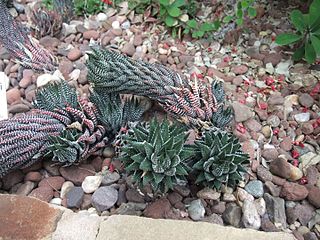
Haworthiopsis reinwardtii, formerly Haworthia reinwardtii, is a species of succulent flowering plant in the family Asphodelaceae, native to the Eastern Cape Province of South Africa. It is one of the species of Haworthiopsis that is commonly cultivated as an ornamental.

Hypoestes phyllostachya, the polka dot plant, is a species of flowering plant in the family Acanthaceae, native to South Africa, Madagascar, and south east Asia. The spots often merge into larger areas of colour.
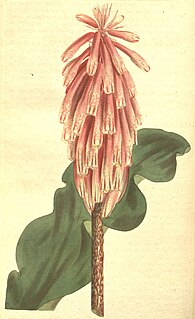
Veltheimia capensis is one of two species of flowering plants belonging to the genus Veltheimia, of the family Asparagaceae. It is a tender bulbous perennial reaching a height of 46 cm (18 in), with flowers varying in color from white with red spots to pink with green or red markings.

Pleiospilos bolusii, the mimicry plant, is a species of flowering plant in the family Aizoaceae, native to the Eastern Cape of South Africa, where it grows at an altitude of 750–1,100 m (2,461–3,609 ft). The species epithet bolusii honours Harry Bolus, a 19th-century South African botanist.

Erica canaliculata, the channelled heath or hairy grey heather, is a species of flowering plant in the family Ericaceae. The species is native to the East and West Capes of South Africa and naturalised in South Australia. It is an erect evergreen shrub, sometimes described as a tree heath. It grows to 2 m, with tiny dark green leaves and large sprays of pink or white flowers with prominent brown anthers in winter and spring.

Eucomis pallidiflora, the giant pineapple lily, is a bulbous species of flowering plant in the family Asparagaceae, subfamily Scilloideae, native to southern Africa. The white to green flowers appear in summer and are arranged in a spike (raceme), topped by a "head" of green leaflike bracts. Some forms reach almost 2 m when in flower. The species is cultivated as an ornamental plant, although it is not hardy in areas where severe frosts occur.
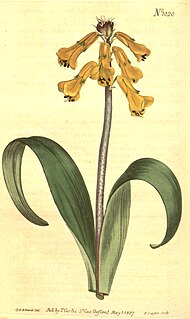
Lachenalia aloides is a species of flowering plant in the family Asparagaceae, native to the Western Cape of South Africa. It is a bulbous perennial growing to 15–28 cm (6–11 in) tall by 5 cm (2 in) broad, with strap-shaped spotted leaves and fleshy stems bearing pendent tubular yellow flowers, red at the tips, in winter and spring. The Latin aloides literally means "aloe-like"; though L. aloides, despite its similarity, does not belong to the same family of plants as aloes.

Lachenalia bulbifera, syn. L. pendula, is a species of flowering plant in the family Asparagaceae, native to the Western Cape of South Africa. It is a bulbous perennial growing to 30 cm (12 in) tall by 5 cm (2 in) broad, with strap-shaped spotted leaves and fleshy stems bearing pendent tubular orange or red flowers 3 cm long, in winter and spring. The Latin bulbifera literally means "bulb-bearing", and refers to the plant's habit of producing bulblets, which can be separated from the parent plant and grown on.

Gasteria baylissiana, Suurberg gasteria, is a species of succulent flowering plant in the family Asphodelaceae, native to the Eastern Cape, South Africa.




















